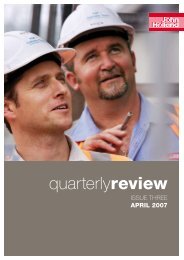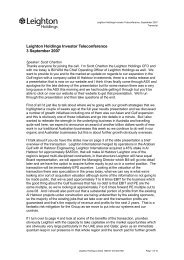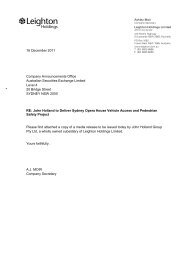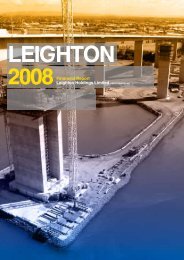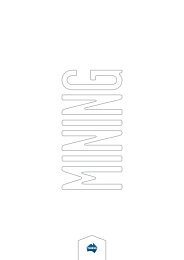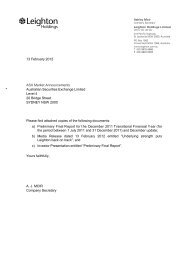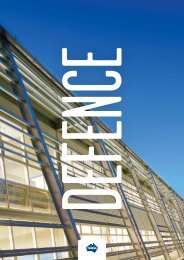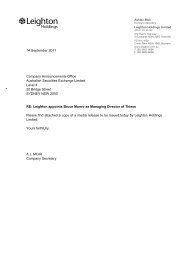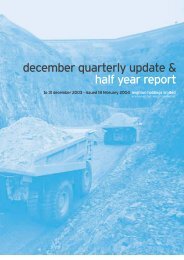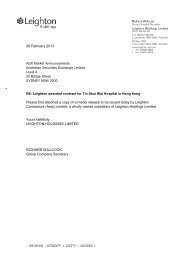PDF - 5.5 MB - Leighton Holdings
PDF - 5.5 MB - Leighton Holdings
PDF - 5.5 MB - Leighton Holdings
You also want an ePaper? Increase the reach of your titles
YUMPU automatically turns print PDFs into web optimized ePapers that Google loves.
<strong>Leighton</strong><br />
<strong>Holdings</strong><br />
Quarterly<br />
Update<br />
2nd<br />
Quarter 14<br />
underground brine outlet tunnel<br />
underground inlet tunnel<br />
underground fresh water pipe<br />
pumping station<br />
pumps<br />
drum screen<br />
residuals area<br />
15Ml tank<br />
15Ml tank<br />
flocculation tanks<br />
filter beds<br />
reverse osmosis building<br />
Gold Coast Desalination Project<br />
now over 50 percent complete<br />
The John Holland Group is part of the GCD Alliance, which was<br />
awarded a contract to construct, operate and maintain the<br />
Gold Coast Desalination Project in December 2005. The GCD<br />
Alliance is comprised of John Holland, Veolia Water, Sinclair<br />
Knight Merz and Cardno, and is delivering the project on behalf of<br />
SureSmartWater - a 50/50 joint venture between Queensland State<br />
Government and Gold Coast City Council.<br />
John Pincock, Project Director of the Gold<br />
Coast Desalination Project, talks about it's<br />
operation and progress.<br />
"The Gold Coast Desalination Plant is a project<br />
capable of delivering 125 megalitres per day<br />
ensuring the future water supply of South East<br />
Queensland. The project is on schedule to supply<br />
first water in November 2008 and full water<br />
capacity in January 2009.<br />
"John Holland is the principal contractor in the<br />
alliance, Veolia provides the process technology,<br />
SKM provides the detailed main plant design and<br />
Cardno provides the detailed pipeline design.<br />
"The project is located at Tugun, on a 6ha site, on<br />
the coast of South East Queensland. The site was<br />
chosen specifically because of its proximity to both<br />
the ocean and also to the existing water pipework<br />
infrastructure. We commenced the project in<br />
August 2006 with remediation of the site which<br />
was an ex-waste disposal area.<br />
"In order to proceed with the project we carried<br />
out a full Environmentally Relevant Activity<br />
Application, involving numerous plans and studies<br />
by various universities to ensure that the impact of<br />
the project on the environment is minimal.<br />
"The project is comprised of three main<br />
components. The first of these are the two<br />
tunnels, an inlet tunnel and an outlet tunnel, one<br />
2.4km long and the other 2.2km and both are<br />
nearing completion. The second component is our<br />
24km pipeline, which is currently at about 9km<br />
laid, and is scheduled to take water around about<br />
mid-June this year. The final component and the<br />
heart of the project is the desalination plant, which<br />
is around 60% complete.<br />
"The two tunnels we are constructing are about<br />
3m in diameter. In order to get the job completed<br />
on time we acquired two Herrenknecht tunnel<br />
boring machines, manufactured in Germany. Once<br />
we are finished with the machines they are buried<br />
out under the sea bed as we are unable to retract<br />
them from the tunnels that they have formed.<br />
"In order to get 100 year durability for the concrete<br />
inlet and outlet tunnels, our segment liners<br />
have metal fibres in the concrete instead of the<br />
standard metal reinforcing. This hasn't been done<br />
for this application before in Australia, although it<br />
has been done in Europe with great success.<br />
"The desalination process is really quite simple.<br />
We take water in from the sea, using a gravity fed<br />
system, through the intake tunnel which is 20m



